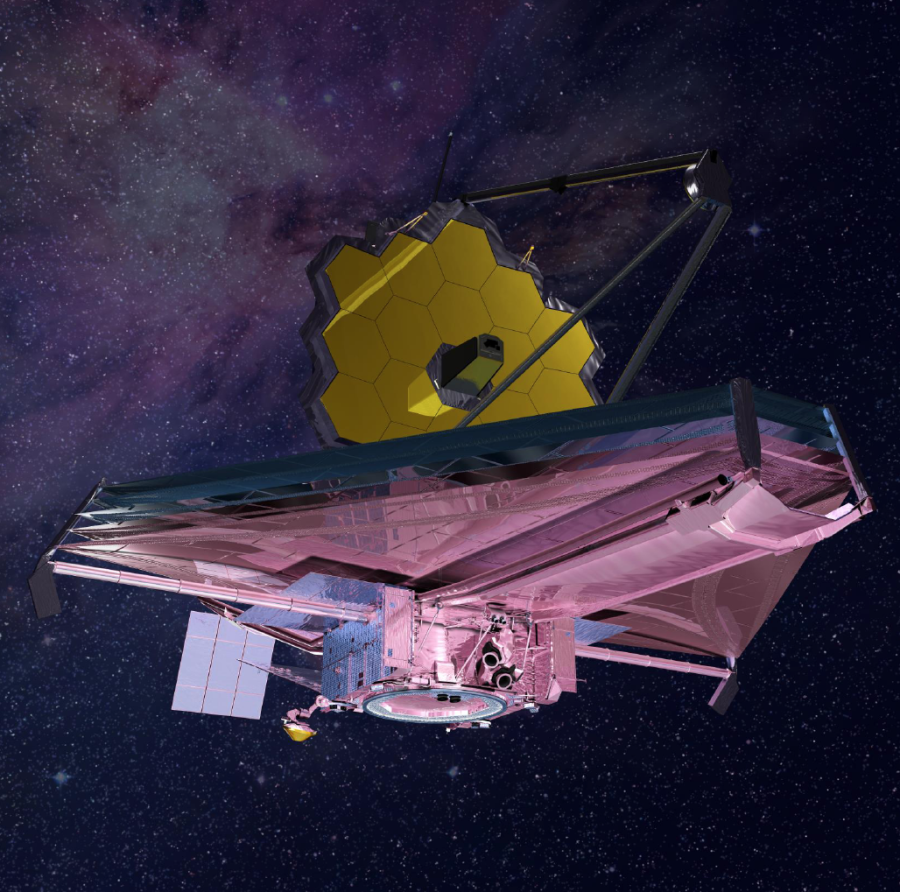James Webb Space Telescope completes 1.5 million kilometer journey from Earth to study evolution of galaxies
Provided by nasa.gov
Artist concept of the James Webb Space Telescope in space. After reaching L2, the JWST will study the formation and evolution of the universe’s earliest galaxies.
January 26, 2022
The James Webb Space Telescope (JWST) completed its 30-day journey into space on Jan. 24 and now floats 1.5 million kilometers away from Earth. From there, it will explore distant galaxies and their pasts to learn about their origins.
The National Aeronautics and Space Administration’s (NASA) latest telescope launched from the Guiana Space Centre in Kourou, French Guiana, on Dec. 25, 2021. Equipped with infrared cameras and its signature set of 18 gold mirrors, the James Webb Space Telescope is the largest of its kind that NASA has ever sent into space.
“Webb was designed in order to be the successor of NASA’s last telescope, Hubble,” upper school physics teacher Dr. Mark Brada said. “The Hubble space telescope has a [2.4] meter diameter mirror, and Webb is almost [three] times as big as Hubble, so almost [nine] times the light gathering power.”
The JWST also traveled much farther than Hubble, ending its journey at the Second Lagrangian Point, or L2, located 1.5 million kilometers behind the Earth as viewed from the Sun. At this point, the JWST can better regulate its temperature and remain stable while observing the universe.
“L2 is where the gravitational effects of the Earth and the Sun cancel out,” said Arnav Swaroop (10), Astronomy Club officer and Physical Sciences Club co-president. “It requires very little energy to keep the telescope going once it gets into orbit. Also, because the James Webb Telescope is in the shadow of the Earth, it can keep itself cool without making any adjustments.”
According to Arnav, the James Webb Space Telescope needs to maintain a low temperature because it was designed to detect faint heat signatures from distant galaxies with minimal interference from nearby objects like the sun. As a result, its mirrors are protected by a sunshield that deflects any heat coming from the sun.
“This telescope is incredibly special because it’s an infrared telescope, and its main focus is to detect small, dim galaxies and exoplanets and their atmospheres from far away,” Arnav said. “Heat is one of the biggest factors in [detecting] infrared. This is why you need to get as far away from the sun as possible while still being able to transmit data back to Earth.”
According to NASA, the JWST will use the infrared data it collects to study the formation of the earliest objects in the universe created by the Big Bang. By looking into deep space and observing far away galaxies, the telescope can essentially look back in time to view the evolution of galaxies from the earliest stages of the universe.
“When Webb is looking at galaxies that are very far away, because light takes billions of years to travel from these galaxies to the telescope, it is also looking at things that are very far in the distant past,” Dr. Brada said. “Webb is principally designed to look at infrared light because all the stuff that’s really far away is primarily giving off light in the infrared part of the spectrum.”
The JWST has three gold plated mirrors, the largest of which spans 6.5 meters in diameter. The large size of the mirrors will allow the JWST to view a wide range of galaxies in their evolutionary processes, helping scientists better understand how an individual galaxy grows and develops.
“Galaxies evolve over billions of years, so we can’t just watch a single galaxy from birth to death,” Dr. Brada said. “But we can look at a bunch of really old galaxies and middle aged galaxies and really young galaxies, and that can help us get the overall picture of how a galaxy evolves.”
With these findings, the JWST will hopefully give humanity a glimpse of the formation of the earliest galaxies, according to upper school physics teacher Dr. Miriam Allersma.
“One part of being human is trying to understand where we came from,” Dr. Allersma said. “And so why not go for it? Why not try to figure out where we came from, and where it all started, and how it all came to be?”




![LALC Vice President of External Affairs Raeanne Li (11) explains the International Phonetic Alphabet to attendees. "We decided to have more fun topics this year instead of just talking about the same things every year so our older members can also [enjoy],” Raeanne said.](https://harkeraquila.com/wp-content/uploads/2025/10/DSC_4627-1200x795.jpg)


















![“[Building nerf blasters] became this outlet of creativity for me that hasn't been matched by anything else. The process [of] making a build complete to your desire is such a painstakingly difficult process, but I've had to learn from [the skills needed from] soldering to proper painting. There's so many different options for everything, if you think about it, it exists. The best part is [that] if it doesn't exist, you can build it yourself," Ishaan Parate said.](https://harkeraquila.com/wp-content/uploads/2022/08/DSC_8149-900x604.jpg)




![“When I came into high school, I was ready to be a follower. But DECA was a game changer for me. It helped me overcome my fear of public speaking, and it's played such a major role in who I've become today. To be able to successfully lead a chapter of 150 students, an officer team and be one of the upperclassmen I once really admired is something I'm [really] proud of,” Anvitha Tummala ('21) said.](https://harkeraquila.com/wp-content/uploads/2021/07/Screen-Shot-2021-07-25-at-9.50.05-AM-900x594.png)







![“I think getting up in the morning and having a sense of purpose [is exciting]. I think without a certain amount of drive, life is kind of obsolete and mundane, and I think having that every single day is what makes each day unique and kind of makes life exciting,” Neymika Jain (12) said.](https://harkeraquila.com/wp-content/uploads/2017/06/Screen-Shot-2017-06-03-at-4.54.16-PM.png)








![“My slogan is ‘slow feet, don’t eat, and I’m hungry.’ You need to run fast to get where you are–you aren't going to get those championships if you aren't fast,” Angel Cervantes (12) said. “I want to do well in school on my tests and in track and win championships for my team. I live by that, [and] I can do that anywhere: in the classroom or on the field.”](https://harkeraquila.com/wp-content/uploads/2018/06/DSC5146-900x601.jpg)
![“[Volleyball has] taught me how to fall correctly, and another thing it taught is that you don’t have to be the best at something to be good at it. If you just hit the ball in a smart way, then it still scores points and you’re good at it. You could be a background player and still make a much bigger impact on the team than you would think,” Anya Gert (’20) said.](https://harkeraquila.com/wp-content/uploads/2020/06/AnnaGert_JinTuan_HoHPhotoEdited-600x900.jpeg)

![“I'm not nearly there yet, but [my confidence has] definitely been getting better since I was pretty shy and timid coming into Harker my freshman year. I know that there's a lot of people that are really confident in what they do, and I really admire them. Everyone's so driven and that has really pushed me to kind of try to find my own place in high school and be more confident,” Alyssa Huang (’20) said.](https://harkeraquila.com/wp-content/uploads/2020/06/AlyssaHuang_EmilyChen_HoHPhoto-900x749.jpeg)












